A few days ago, the AfD won 12.6% of the vote and 94 seats in Germany, which immediately prompted the usual hysteria about how the nazis are coming back. I don’t know what’s with the sophisticates and this need to see fascists everywhere. (Well, I actually know exactly what this is about, but it’s a story for another time.) Antifascism has never been as popular as since there are no fascists anymore, which I guess makes sense, since it’s both less dangerous and more rewarding in the absence of any real fascist threat. (To see what a bunch of dangerous nazis the people at the AfD are, see this video taken by Orit Arfa, who writes for the Jerusalem Post, in Munich on the night of the election.) Anyway, after the election, people started talking about the danger of antisemitism, as if the AfD’s electoral success were due to antisemitism. In fact, not only is the AfD’s electoral success not due to antisemitism, but anyone who lives in the real world knows that, if Jews are threatened in Europe, it’s not by the far-right. A report on antisemitic violence in Europe recently published by the Center for Studies of the Holocaust and Religious Minorities and the Center for Research on Extremism, both at the University of Oslo, confirms that in case you had any doubt.
Here is the abstract of the study in question:
How often do incidents of antisemitic violence occur in contemporary Europe, and what trends are showing? How exposed are Jewish populations in different countries? Who commits these crimes? We need to answer such questions as precisely as possible in order to effectively combat and prevent antisemitism in general and violent antisemitism in particular, but we lack the knowledge to do so because systematic studies of the subject are few and far between.
As a step towards filling this research gap, the current report presents some tentative findings about violent antisemitism in a sample of European countries and proposes directions for further research.
Combining incident data based on police reporting with a 2012 survey on antisemitism carried out by the European Union’s Fundamental Rights Agency (FRA), this report tentatively compares the levels of antisemitic violence in different countries. The seven-country sample contains comparable data for France, UK, Germany and Sweden only. Among these countries, Jews’ exposure to antisemitic violence appears to have been highest in France, lower in Sweden and Germany, and lowest in the United Kingdom.
Figures for Norway, Denmark and Russia are not directly comparable because of differing data sources. However, Russia clearly stands out with a very low number of incidents considering Russia’s relatively large Jewish population. Russia is also the only case in which there is little to indicate that Jews avoid displaying their identity in public.
Available data on perpetrators suggest that individuals of Muslim background stand out among perpetrators of antisemitic violence in Western Europe, but not in Russia, where right-wing extremist offenders dominate. Attitude surveys corroborate this picture in so far as antisemitic attitudes are far more widespread among Muslims than among the general population in Western Europe.
The findings presented here are tentative. More and better data as well as more research are needed in order to form a more accurate picture of the nature and causes of antisemitic violence, a prerequisite for determining relevant countermeasures.
If the authors of that study are really wondering how to prevent antisemitic violence, they might want to talk with people at the AfD, who I think have a few ideas on that issue…
It’s pretty difficult to estimate the prevalence of antisemitic violence in Europe. If we look at incidents that were reported to the police, it seems relatively low though hardly negligible.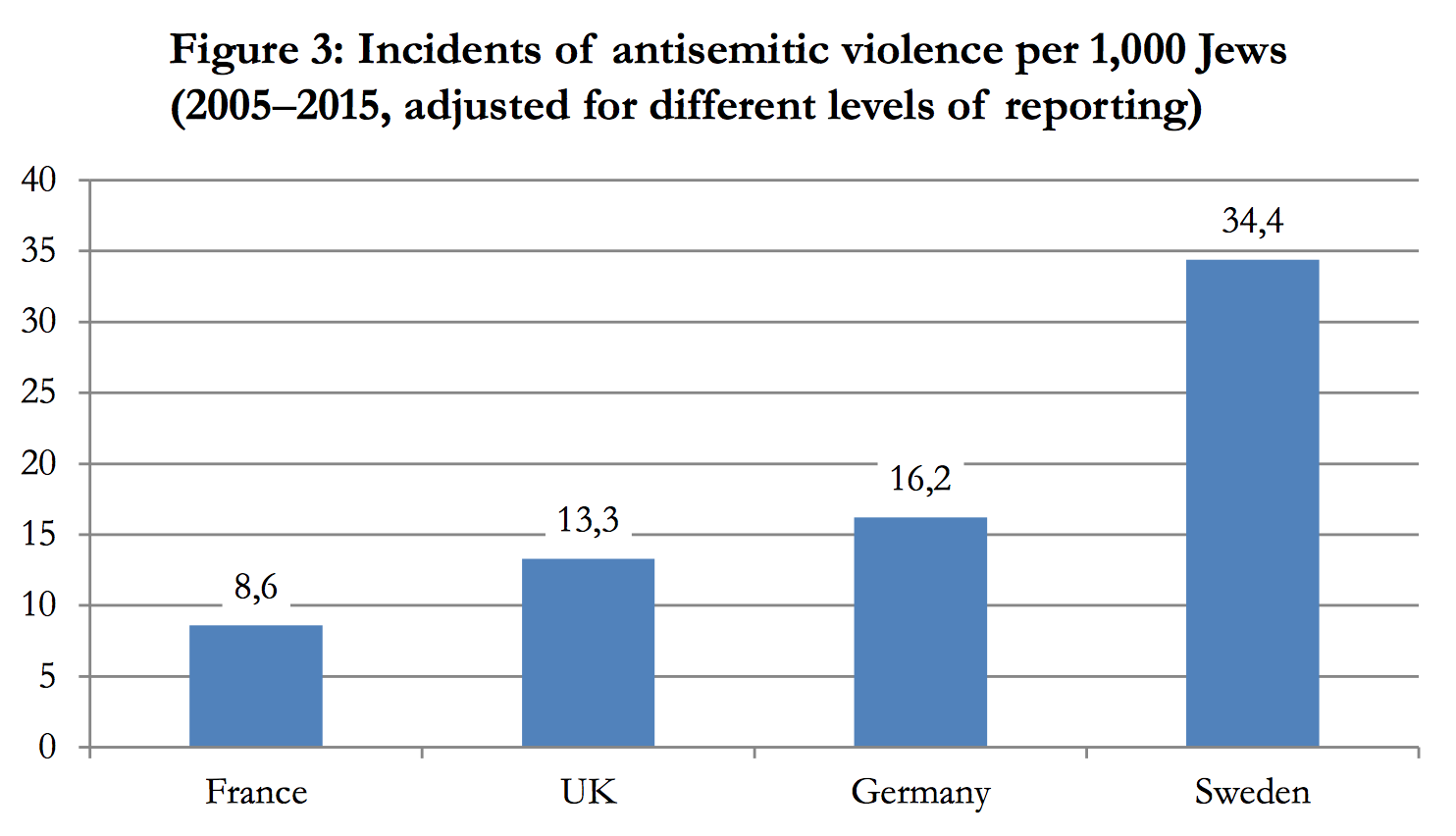 By comparison, according to the NCVS, the victimization rate for serious violent crime (rape/sexual assault, robbery and aggravated assault) is 6.6 per 1,000 in the US. Moreover, since there are probably many antisemitic physical attacks that are never reported to the police, these figures presumably underestimate the phenomenon, which in any case seems to be significantly more common than serious violent crime in the US. It should also be noted that, although the figures were adjusted to account for the fact that that levels of reporting are not the same in different countries, it’s not clear that we can trust the ranking induced by police data.
By comparison, according to the NCVS, the victimization rate for serious violent crime (rape/sexual assault, robbery and aggravated assault) is 6.6 per 1,000 in the US. Moreover, since there are probably many antisemitic physical attacks that are never reported to the police, these figures presumably underestimate the phenomenon, which in any case seems to be significantly more common than serious violent crime in the US. It should also be noted that, although the figures were adjusted to account for the fact that that levels of reporting are not the same in different countries, it’s not clear that we can trust the ranking induced by police data.
Indeed, according to a survey conducted in 2012 by Ipsos for the Agency for Fundamental Rights of the European Union (FRA), not only is the prevalence of antisemitic violence much higher in France, but the ranking of the countries is completely different.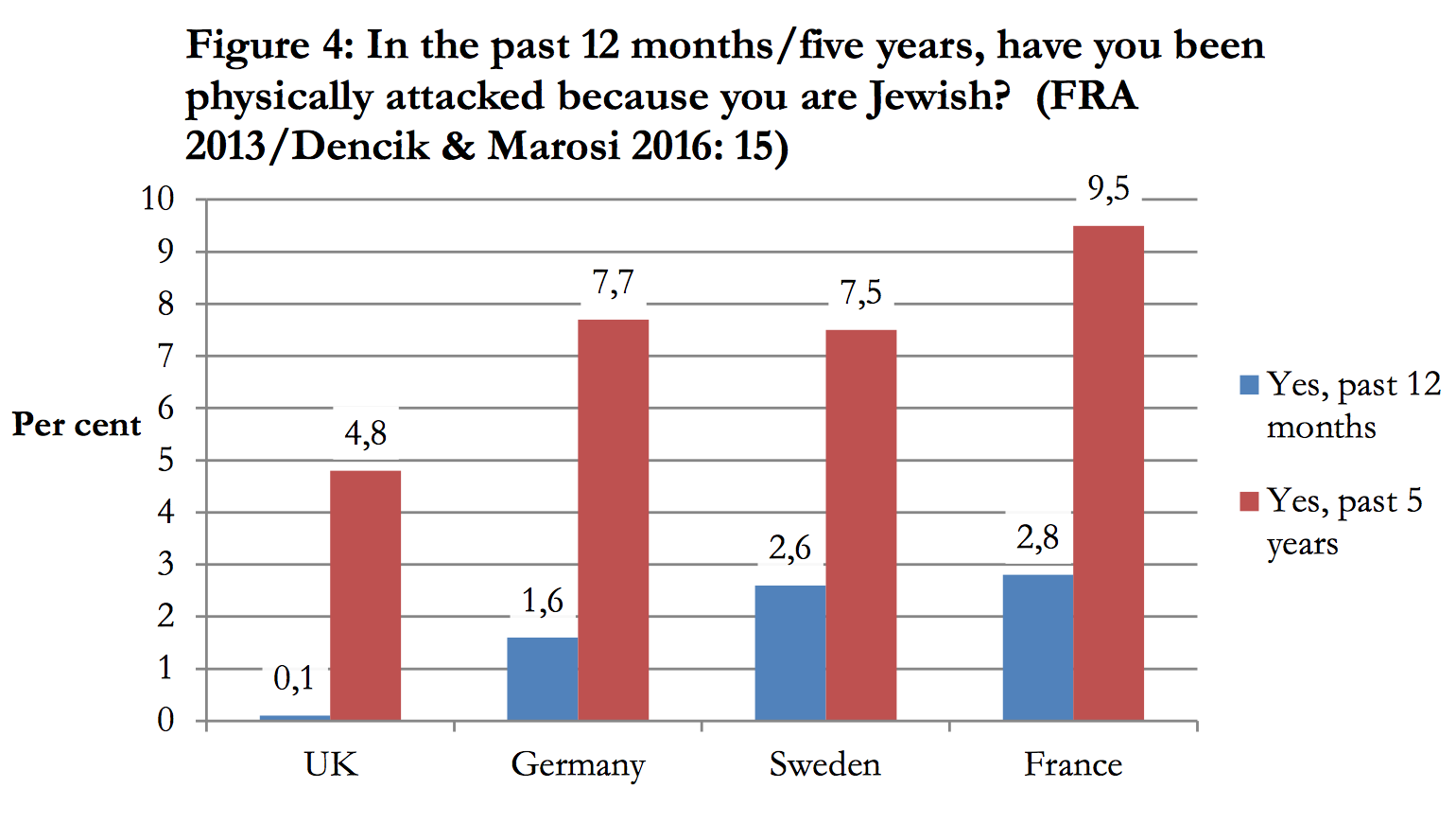 These figures are pretty scary, but a few caveats are in order. First, the survey was conducted online and the sample was not random, so there may be selection bias. This survey probably overestimates the prevalence of antisemitic violence, but it’s hard to know by how much. (However, note that in the case of Sweden, the rate is lower than the one based on police reports.) It’s also worth noting that, while not strictly speaking inconsistent, the estimates for the UK don’t make a lot of sense. If only 0.1% of the respondents were physically attacked because they’re Jewish in the past 12 months, then unless the prevalence of antisemitic violence decreased a lot just before the survey was conducted, it’s impossible that 4.8% of the respondents were attacked because they’re Jewish during the past 5 years. Judging by the estimates for the other countries and the rate calculated from police reports, the estimate for the past 12 months in the UK is probably too low, though again it’s impossible to know by how much.
These figures are pretty scary, but a few caveats are in order. First, the survey was conducted online and the sample was not random, so there may be selection bias. This survey probably overestimates the prevalence of antisemitic violence, but it’s hard to know by how much. (However, note that in the case of Sweden, the rate is lower than the one based on police reports.) It’s also worth noting that, while not strictly speaking inconsistent, the estimates for the UK don’t make a lot of sense. If only 0.1% of the respondents were physically attacked because they’re Jewish in the past 12 months, then unless the prevalence of antisemitic violence decreased a lot just before the survey was conducted, it’s impossible that 4.8% of the respondents were attacked because they’re Jewish during the past 5 years. Judging by the estimates for the other countries and the rate calculated from police reports, the estimate for the past 12 months in the UK is probably too low, though again it’s impossible to know by how much.
While it’s impossible to get a precise idea of the prevalence of antisemitic violence in Europe without a victimization survey which uses a representative sample of the Jewish population in each country, it’s clearly much higher than we’d like and, were it not for the fact that Jews aren’t stupid and avoid neighborhoods were antisemitism is common, it would be even higher. I know a few places in the suburbs of Paris where, if you’re wearing a kippa, you better know how to run fast… So who is responsible for antisemitic violence in Europe? Listening to some commentators, you would think that it’s because of far-right thugs, but that’s not what the survey conducted by Ipsos for the FRA shows.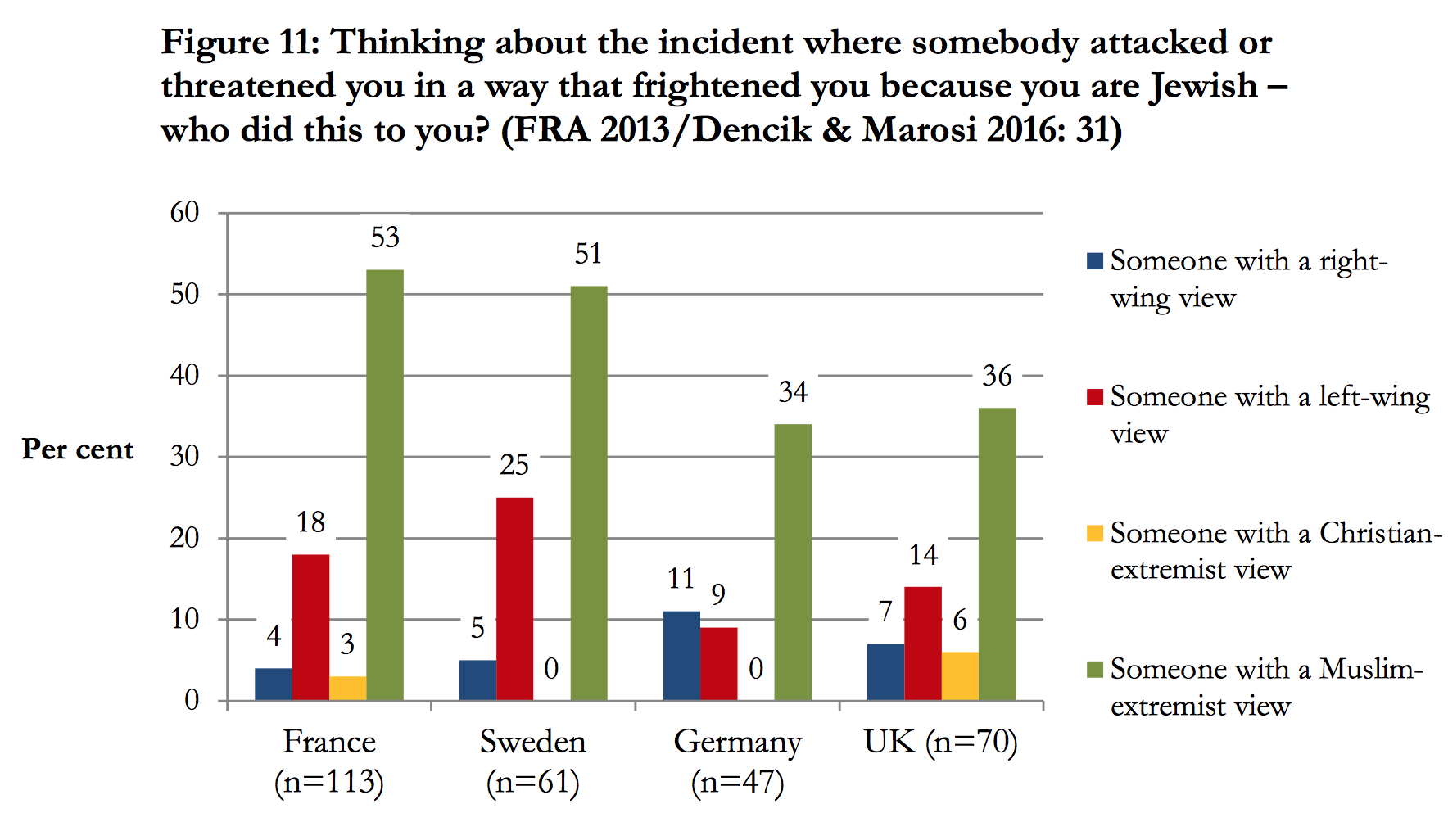 As you can see, not only are the vast majority of antisemitic attacks perpetrated by muslims, but attacks by people with left-wing views seem to be more common than attacks by christians and people with right-wing views. (Note that respondents could pick more than one answers and that, although the graph only shows 4 possible answers, there were many others.) In the case of Germany and the UK, a relatively large proportion of respondents didn’t pick any of the possible answers shown in this graph, but this doesn’t seem to be the case for Sweden and France even under pessimistic assumptions about the overlap in the responses.
As you can see, not only are the vast majority of antisemitic attacks perpetrated by muslims, but attacks by people with left-wing views seem to be more common than attacks by christians and people with right-wing views. (Note that respondents could pick more than one answers and that, although the graph only shows 4 possible answers, there were many others.) In the case of Germany and the UK, a relatively large proportion of respondents didn’t pick any of the possible answers shown in this graph, but this doesn’t seem to be the case for Sweden and France even under pessimistic assumptions about the overlap in the responses.
Note also that, while as I noted above selection bias is a concern for this survey, I don’t think it’s nearly as much of a concern if we’re using it to determine the identity of the perpetrators as opposed to calculate the prevalence of antisemitic violence. It makes sense that people who have been victim of antisemitic violence would be more likely to participate in such a survey, but it’s really not clear that people who have been attacked by muslims or far-left activists would be more likely to do so than people who have been attacked by far-right activists. (The respondents didn’t know they were going to be asked questions about the motivations of the perpetrators of antisemitic violent attacks.) Even if that were the case, the disparity according to this survey is so huge that, in order to find that kind of results if muslims were not responsible for the vast majority of antisemitic violence, selection bias would have to be ridiculously large. This is all the more unlikely that, as I point out below, multiple polls have shown that in Europe antisemitism was far more common among muslims than in the rest of the population. Since presumably people who have antisemitic beliefs are more likely to commit violent attacks against Jews, it really shouldn’t come as a surprise that muslims commit the majority of antisemitic violent attacks in Europe.
Note that, in Germany, police statistics paint a strikingly different picture of the perpetrators of antisemitic violence.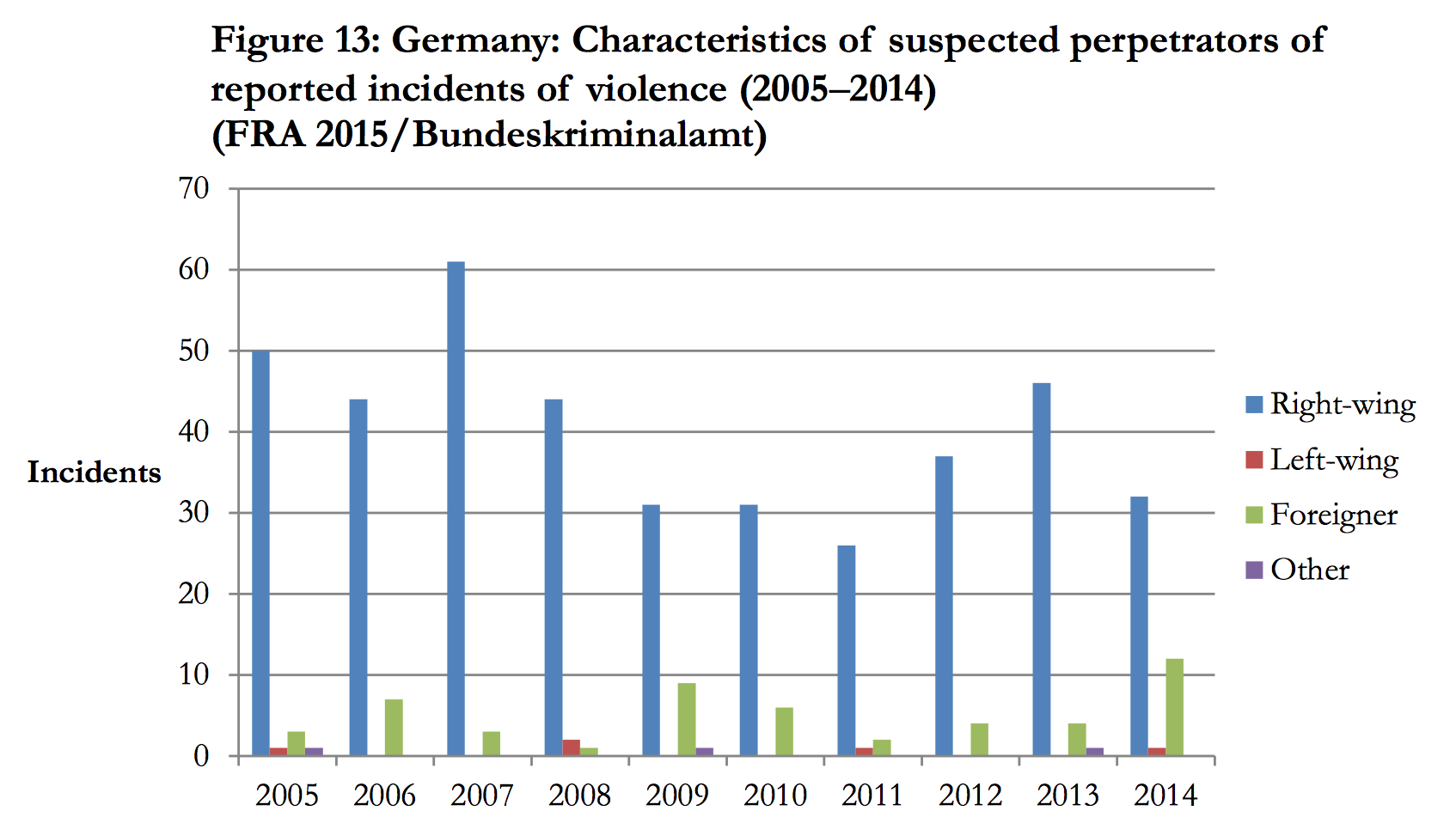 This contradicts the results of the survey, but there are various problems with these figures.
This contradicts the results of the survey, but there are various problems with these figures.
As the authors of the study note, when it comes to antisemitism, it’s really not clear how seriously we should take the statistics from the police:
German police statistics suggest that far-right actors commit most of the violence (see Figure 13). How can this be explained? Perhaps the share of right-wing perpetrators is in fact larger than indicated by the results of the FRA survey. We could also be looking at a categorisation problem. Could it be that German police considers antisemitism a right-wing type of ideology and thus categorises most antisemitic attacks as right-wing, regardless of the perpetrator’s ethnic or religious background? Another issue is the nature of violent incidents categorised by German authorities as anti-Israeli and not antisemitic. In 2014, German police registered 91 violent anti-Israeli incidents (most of them perpetrated by “foreigners”), and one of them, controversially, involved the fire-bombing of a synagogue. The question is how many of the other “anti-Israeli” incidents should really be considered acts of antisemitism. More research is required to clarify this issue.
Personally, I’d trust the results of a victimization survey, even one with selection bias, over estimates that come from police reports anytime, but maybe that’s just because I’m a horrible islamophobe. (See also this article for more on the issue of the reliability of police data regarding antisemitism, which mentions another survey that also shows most antisemitic violent attacks were committed by muslims.) Moreover, although there are cultural differences between countries, it would be really surprising if the identity of the people who commit antisemitic violence in Germany was so different than in other European countries.
It’s also worth noting that several polls have shown that antisemitism is far more widespread in Germany among muslims than in the rest of the population. For instance, according to a poll conducted by the ADL in 2015, 56% of muslims in Germany harbor antisemitic attitudes, compared to 16% for the population as a whole. (This means that, among non-muslims, only 11.5% of the population is antisemitic in the sense of the ADL. Moreover, the ADL uses a very broad definition of antisemitism, but as other polls suggest, the disparity between muslims and non-muslims becomes much larger when you use a more narrow definition. For instance, according to the Pew Global Survey conducted in 2006, 31% of muslims in Germany declared they had a very unfavorable view of Jews, whereas only 5% of the general population did. This means that, among non-muslims in Germany, the proportion of people who say they have a very unfavorable view of Jews is even less than 5% and, therefore, muslims are more than 6 times more likely to say they have a very unfavorable view of Jews than non-muslims.) They also seem to commit crime in general and violent crime in particular at several times the rate of non-muslims. Thus, it would be surprising if the figures based on police reports were accurate, even if muslims are still a relatively small minority in Germany.
While there is still plenty of denial about the reality of antisemitism in Europe, the fact that it predominantly comes from muslims has become so obvious, that even the mainstream media now talks about the problem. But as the comments about the result of the federal elections in Germany show, attempts to obfuscate this reality by pinning antisemitism and, more generally, political violence on the far-right are still common. The same thing can be observed about homophobia in Europe, which the media constantly tries to present as a right-wing problem, even though everybody knows that it’s far more common among muslims. For instance, when a homosexual couple was viciously attacked in France during the protests against the bill that legalized homosexual marriage, the attack was almost unanimously blamed on catholic protesters by the media. Yet, when the perpetrators were convicted a year later, we learned in the press that one of them was named Taieb and the other Malik, which as everybody knows are typical catholic names.
Similarly, while the media focuses on violent right-wing extremism, Europol has consistently found that it was largely non-existent and, in any case, far less common than left-wing violent extremism. For instance, there are virtually no places in France where a left-wing activist would be physically threatened, but go to a French university with a National Front t-shirt and see what happens to you… The truth is that, when it comes to political violence, the National Front is far more often on the side of the victims than on the side of the perpetrators. But you’re not supposed to say that, for it’s important that people continue to believe the National Front poses a fascist threat, lest more of them start voting for it. Fortunately, since journalists rarely let the truth get in the way of “politically responsible reporting” (i. e. what some people who aren’t as delicate as me would call “propaganda”), most people have no idea.
EDIT: I think I now understand why the rate of victimization is very low in the UK for the past 12 months, whereas for the past 5 years it’s more in line with the rates observed in the other countries. Unlike figure 11, which includes data about both physical attacks and threats, figure 4 is only about physical attacks, which unsurprisingly are far less common. The problem with rare events is that, when you use a survey to estimate their prevalence, sampling error is a big issue. So my guess is that, if the rate for the past 12 months is so low in the UK, it’s largely a result of chance. This problem can be mitigated by asking respondents if they have been victim of a physical attack in the past 5 years and, as I noted above, the proportion of respondents in the UK who have, although lower than in other countries (which is consistent with the rates estimated on the basis of police reports), is more or less in the same ballpark. This explanation is also consistent with the results of the survey when you look at both physical attacks and threats of violence.
As you can see, the UK is no longer an outlier and there is no longer a discrepancy between the rate for the past 12 months and that for the past 5 years, which is unsurprising because including threats of violence and not just actual physical violence makes that kind of events significantly more likely and therefore reduces the probability that sampling error will produce an extreme result.
ANOTHER EDIT: Some people refuse to believe that most of the perpetrators of antisemitic violent attacks are muslim are the majority, because they worry about selection bias in the survey conducted by Ipsos for the FRA, but I don’t think the possibility of selection bias is sufficient to reject the conclusion. First of all, as I noted above, while selection bias is a real concern if you try to use this survey to calculate a victimization rate for violent antisemitic attacks, I doubt it’s really a problem if you use it to estimate the characteristics of the perpetrators. Clearly, people who have been victims of antisemitic violence are presumably more likely to participate in a survey about antisemitism, but I don’t see why people who have been victim of antisemitic violence perpetrated by muslims would be more likely to participate in such a survey than people who have been victim of antisemitic violence perpetrated by someone else. Moreover, as I also noted above, the results of the survey are so lopsided that, in order to invalidate the conclusion I drew from it, selection bias with respect to the characteristics of the attacker would have to be implausibly large. The fact that a survey might be affected by selection bias is not a reason to reject the conclusion someone draws from it, unless you can also show that selection bias was plausibly large enough to invalidate the conclusion, which I think is clearly not the case here.
A back-of-the-envelope calculation is sufficient to show how implausibly large selection bias would have to be in order for it to be the case that most of the antisemitic violent attacks in Europe are committed by muslims. Let’s take the case of Sweden and, to keep things simple, assume that 60% of the respondents who said their attacker had a left-wing view also said he had a muslim-extremist view, while none of those who said their attacker had a right-wing view also said he had a muslim-extremist view. Under this very implausible assumption, which assumes a lot of overlap between the categories, 34% of the respondents didn’t pick any of the 4 possible answers shown in figure 11. Let’s assume that, among these 34%, 50% were attacked by a far-right person, 25% by a left-wing extremist and 25% by a muslim. Furthermore, again to keep things simple, let’s assume that in this group there was no overlap between the categories. These assumptions strike me as completely implausible. It would mean that, for the respondents who didn’t choose any of the 4 possible answers shown in figure 11, attackers were 6.6 times more likely to have a right-wing view, 50% more likely to have a left-wing view and more than 3 times less likely to have a muslim-extremist view than for the respondents who picked one of the 4 possible answers shown in that figure. Finally, I will assume that the survey didn’t underestimate the proportion of perpetrators who had a left-wing or christian view, though it may have overestimated it.
Yet, even under such ridiculous assumptions, in order for the conclusion that most of the perpetrators are muslim to be false, it would have to be the case that people whose attacker was muslim were at least 2.7 times more likely to participate in the survey than people whose attacker had a right-wing view. As I explained above, it’s not even clear to me why there should be more than a negligible selection bias with respect to the characteristics of the perpetrators and, to the extent there is, I don’t see why it should work against muslims. But in any case I don’t see how anyone reasonable could think it’s plausibly as large as 2.7, which again is how large it would have to be to invalidate the conclusion I draw from this survey under totally ridiculous assumptions. In fact, it would need to be even larger than that, so I really don’t see how the possibility of selection bias could be sufficient to justify that we suspend our judgment about who commits violent antisemitic attacks in Europe. This is all the more true that, given what is known about the prevalence of antisemitism among muslims in Europe compared to non-muslims, the rate at which they commit violent crime relative to non-muslims and the identity of the perpetrators of antisemitic violence in cases that are discussed in the media, the results of this survey should not come as a surprise to anyone.
ONE LAST EDIT: I just came across this study by the Pew Research Center, which evaluates surveys based on online non-probability samples. The average bias observed in the samples they tested, even those which fared the worst, is not even close to being large enough to invalidate the conclusion of this post. It was also revealed yesterday that, after Mohammed Merah murdered a French soldier in 2012, one police officer had identified him as the culprit, but he was ignored because the police favored the hypothesis that the far-right was behind this attack. As a result, Merah remained free and went on to attack a Jewish school, where he killed one adult and three small children. The same thing happened after the attack of the rue Copernic in 1980, which killed several Jews. Investigators were pressured by the government to go after the far-right, when in fact it was later revealed that pro-Palestinian terrorists were responsible, which the police suspected from very early on.
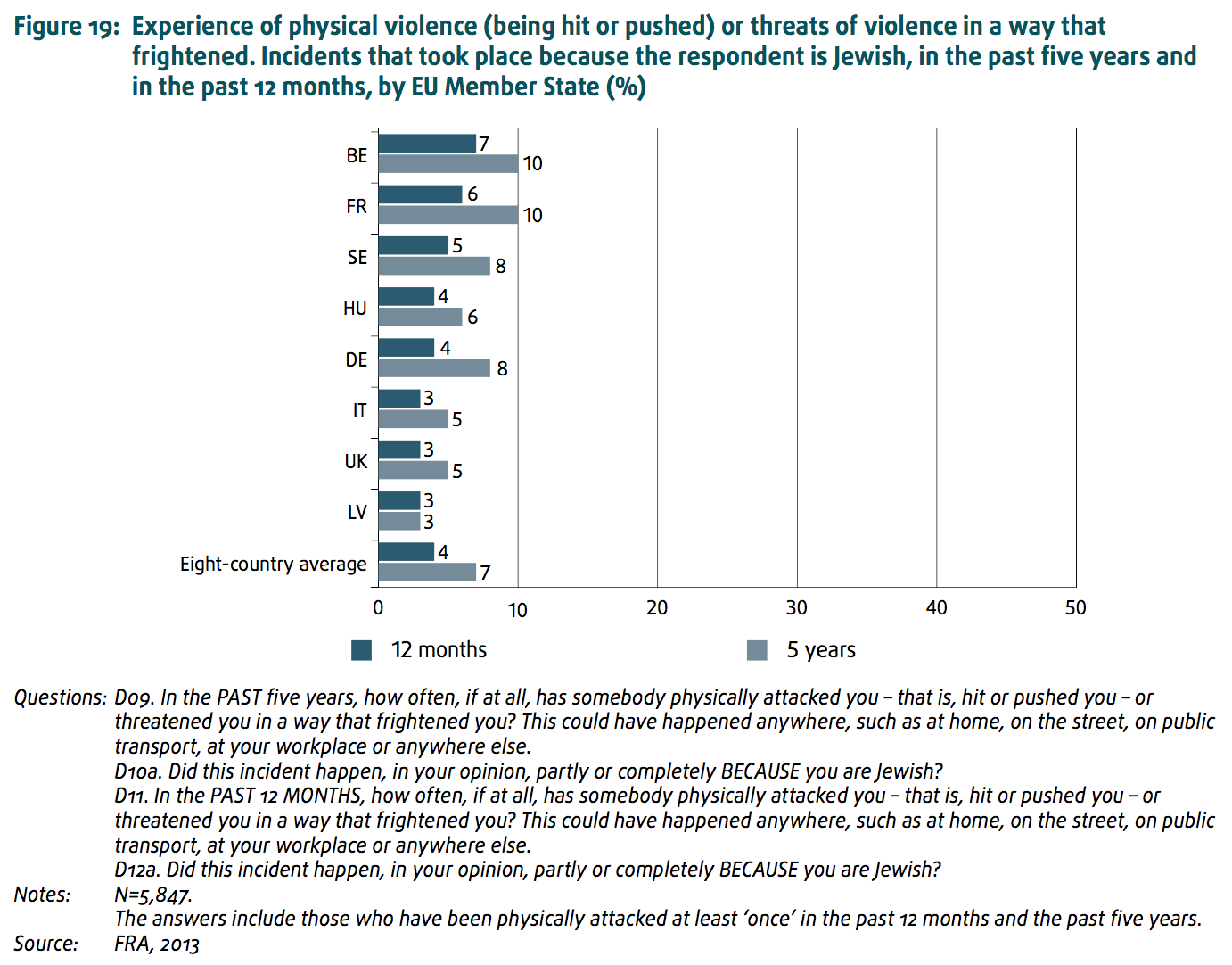
In this post, you tend to group Muslims together with people with left-wing views. Now, it’s true that many Muslims don’t have the same views as are characteristic of those on the right or far-right in Europe. But it might nevertheless be accurate to characterize some Muslims as falling on the right rather than the left. That doesn’t contradict your saying “it’s not neo-Nazis”, but it might complicate what we have to say about whether “the right” or “the left” is responsible for more antisemitic violence.
I had a similar thought about the very high rate of “extremist-right” attacks reported in Germany – perhaps the German police consider anti-semitic or anti-Israel attacks to be right-wing by default unless the victim states otherwise, or the attacker was clearly a leftist.